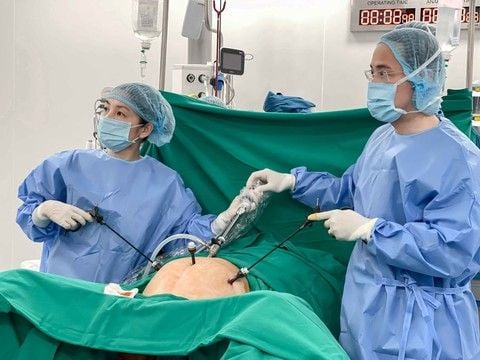There are multiple ways to breastfeed your baby. You may switch both sides and feed your baby from both breasts at once. Your baby's habits and your comfortable breastfeeding position will determine your breastfeeding type. So why does your infant breastfeed on one side, and is there certainly to be concerned about?
1. What are the primary explanations for breastfeeding on just one side?
You may need or choose to breastfeed from just one side in a variety of situations, including:
- Your milk supply is plentiful: Breastfeeding on one side at each feeding (or even on the same side for several consecutive feedings) can help slow breast milk production on the opposite side of your breasts.
- Breastfeeding on both breasts can occasionally result in abdominal pain symptoms in babies, particularly if you have a plentiful milk supply. Offering your baby one breast at a time during feedings may help ease symptoms such as demanding behavior (Colic syndrome), indigestion, rapid weight gain, and green stools.
- Baby's habits: Some infants prefer drinking from one breast, not the other. Most newborns can obtain enough breast milk from just one breast, so don't panic if your baby prefers feeding on one side.
- Sometimes, a breast issue causes a baby to refuse to breastfeed on one side. Consult your physician if your infant refuses to breastfeed on one side. It's merely an individual choice, so there's no need to worry if your doctor has ruled out any underlying medical issues and the baby is developing steadily.
- You have painful breasts: Breastfeeding on the affected breast may be uncomfortable if you have blisters on your nipples, a breast infection, irritated nipples, or a skin condition (such as dermatitis or eczema) on one side. If this occurs, breastfeeding exclusively from a healthy breast can promote the healing of the injured breast.
- You only have one functioning breast: As long as the healthy breast is still producing breast milk, you can continue to nurse on the unaffected breast from the opposite breast if you have undergone breast cancer therapy, a mastectomy, or surgery on only one breast.
You can make enough breast milk to feed your baby with just one functioning breast, but you should still monitor your milk supply and your baby's weight. You can still supplement your feeding with formula if you cannot make an entire breast milk supply.
Because the two breasts work separately, breastfeeding from only one breast does not result in significant issues. The second breast will revert to its pre-pregnancy condition if you decide to use only one. In this situation, there will be a noticeable distinction in breast size between the breastfeeding and non-breastfeeding breasts, but the variation often goes away once feeding happens. Because some women who breastfeed from only one breast have a higher risk of breast cancer than those who provide from both sides, evidence indicates that using both may be the best option.
However, a broader study conducted in the last ten years has revealed that women who continue to breastfeed after their child approaches the age of two are 30% less likely to develop premenopausal breast cancer. Cervical cancer risk may also be decreased by breastfeeding.

2. Advice for One-Side Breastfeeding
Choosing to breastfeed on one side at every meal has its benefits, as it can be advantageous in certain conditions, and some find it more convenient. If you are breastfeeding on just one breast, there are a few considerations to make.
If you can feed from both breasts, switch up which breast you use. Start your second feeding of the day on your left breast, for instance, if your first is on the right side. Using that method will enable both breasts to accumulate and sustain a consistent and plentiful milk supply on both sides.
You will eventually slow down the milk production on the breast you are not using if you continue to breastfeed on only one breast without switching to the opposite one.
2.1. Let your baby nurse for as long as they want
Give your infant as much time as they desire to feed themselves on the breast while you are only breastfeeding on one side at a time. However, you must ensure that your infant receives as much breast milk from that side as possible.
Your infant can get the fattier, creamier hindmilk at the end of longer meals. Your baby will stay fuller between feedings if you embrace hindmilk.
Allowing your infant to feed for extended periods also encourages your body to produce more milk and helps you empty your breast completely.

2.2. Breast engorgement
Breastfeeding from only one side at a time has the drawback of potentially causing pain and over-engorgement in the unfed breast. During the first few weeks, while your milk supply adapts to your baby's needs, you are more likely to feel this engorgement.
Over-engorged breasts can also result in mastitis and other frequent problems while breastfeeding including plugged ducts.
Using a breast pump or expressing milk manually to extract some milk from the engorged breast until you can feed your baby on that side may reduce pressure and discomfort if you suffer engorgement on one side while breastfeeding on the other.
The condition of breast engorgement will improve over time. As you continue to breastfeed your baby from one side per feeding session, your body will gradually adapt.
2.3. Treating Breast Inequalities
Your breasts may be unequal in size if you breastfeed from one side at a time. As it fills up with breast milk for the subsequent feeding, the breast you breastfed the previous time will get smaller, and the other breast will get bigger.
The mother herself typically has no issues as a result of unsimilar breasts. Inequalities can even be beneficial because they simplify remembering which breast to use for the following feeding.
However, if the appearance of unequal breasts bothers you, you might try to maintain more even breasts by feeding from both breasts at every single meal.
2.4. Continue expressing milk
You should continue expressing milk using a breast pump or manually from the injured breast to continue producing breast milk if you are only breastfeeding from one breast since the other breast needs time to heal from illness or rest. Your milk production will decline if you don't frequently stimulate that breast.
While some people will have more options than others, it is ultimately up to you how you want to give milk. There is no right or wrong method to breastfeed as long as your infant receives enough milk and develops steadily.
If possible, offer both breasts at each feeding during the first few weeks of breastfeeding (when establishing your milk production). You can do whatever is most comfortable and convenient for you and your child once you start getting a healthy and consistent milk supply, which should happen four to six weeks after birth.

3. When should You visit a healthcare professional?
Your kid may only feed on one side at a time because they won't eat on the other. You can continue to use the same breast for every feeding and still produce a complete and healthy supply of breast milk with just one breast. However, the flavor of your breast milk may be variated due to specific medical issues. If your infant is not breastfeeding on one breast, it can indicate a medical problem (e.g., breast infection or even potential cancer in that breast).
If your infant is not feeding on one breast, it is recommended that you communicate with your physician. A breast exam is the only way to determine the exact cause of your baby's one-sided breastfeeding, even if it's not a significant one.
To arrange an appointment, please call HOTLINE or make your reservation directly HERE. You may also download the MyVinmec app to schedule appointments faster and manage your reservations more conveniently.
Reference sources: babycenter.com, verywellfamily.com, medela.us
To arrange an appointment, please call HOTLINE or make your reservation directly HERE. You may also download the MyVinmec app to schedule appointments faster and manage your reservations more conveniently.


